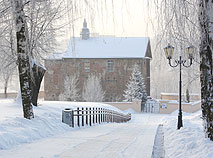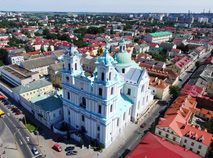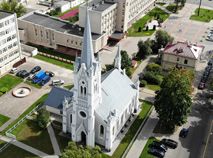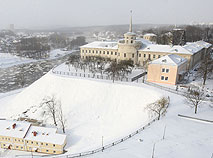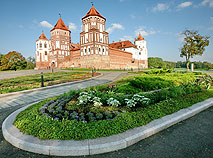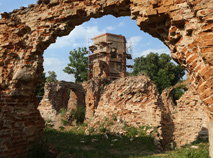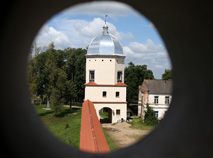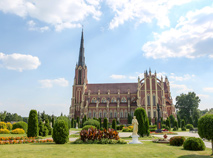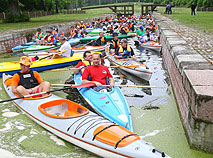Grodno Oblast Landmarks

The western region of Belarus – Grodno Oblast – is famous for its castles and palaces of renowned European dynasties, magnificent temples of various denominations and the surprisingly picturesque nature. It is home to over 1,500 specimens of history and culture, including the world heritage: the castle complex Mir, the Struve Arc, part of the wildlife sanctuary Belovezhskaya Pushcha… In the ancient town of Novogrudok the Grand Duchy of Lithuania was born. Important events of Belarusian history took place in Krevo. The royal city of Grodno is still a unique architectural pearl of Belarus…
Augustow Canal

The Augustow Canal is an engineering masterpiece of the 19th century, an artificial waterway connecting the Baltic Sea and the Black Sea. It is one of the world’s most remarkable canals alongside with the Gota Canal in Sweden and the Caledonian Canal in Great Britain. Here you will see unique hydro-technical installations, will be able to have a steamboat voyage or go kayaking amidst picturesque and pristine landscapes. The canal is located in the Augustow Primeval Forest (Augustow Pushcha) which is called “Europe’s green lungs”.
![]() One needs about an hour to pass the 9.6-meter long Nemnovo sluice, the Augustow Canal’s biggest sluice. More interesting facts and figures are available here.
One needs about an hour to pass the 9.6-meter long Nemnovo sluice, the Augustow Canal’s biggest sluice. More interesting facts and figures are available here.
![]() Grodno District, border area between Belarus and Poland
Grodno District, border area between Belarus and Poland
Palace and Park Ensemble in Svyatsk

This legendary palace will remind you of the French Versailles. The palace was built by Italian architect Giuseppe de Sacco in the 18th century. It used to be a family nest of the Volovichy clan. It includes a picturesque English park, artificial ponds and canals connected by galleries. Centuries ago the park was famous for its exotic plants cultivated by owners of the Svyatsk village. After the renovation, the historical building will turn into a multi-purpose facility with a recreation center, a hotel, a restaurant and a cafe.
![]() The history of the mansion is surrounded by myths and legends. According to them, the owner of the palace ordered to mure his young daughter into one of the columns of the mansion when he found out that she was in love with a horseman. They say that the ghost of the youth girl still roams the palace.
The history of the mansion is surrounded by myths and legends. According to them, the owner of the palace ordered to mure his young daughter into one of the columns of the mansion when he found out that she was in love with a horseman. They say that the ghost of the youth girl still roams the palace.
![]() Svyatsk, Grodno District (near the Augustow Canal)
Svyatsk, Grodno District (near the Augustow Canal)
Old Castle and New Castle in Grodno

The first defense installation was built in Grodno on the bank of the Neman River in the 11th century. The facility was meant to protect the town from Crusaders. Upon the order of Grand Duke Vitaut, the building was transformed into a gothic castle and became one of the major residences of the legendary duke. During the reign of King Stephen Bathory the castle was remodeled to become a Renaissance-style palace and park ensemble. It was under Stephen Bathory that the palace acquired its modern look. The New Castle was erected nearby in the 18th century as a royal residence. It was there where the agreement on the Third Partition of the Polish-Lithuanian Commonwealth (Rzeczpospolita) was signed.
![]() Today the Old Castle and the New Castle are part of the Grodno History and Archeology Museum. The collection exhibited at the castles features about 7,000 items.
Today the Old Castle and the New Castle are part of the Grodno History and Archeology Museum. The collection exhibited at the castles features about 7,000 items.
![]() 2 Zamkovaya Street, Grodno
2 Zamkovaya Street, Grodno ![]() Tue-Sun, 10:00-18:00
Tue-Sun, 10:00-18:00
St. Francis Xavier (Farny) Cathedral

This magnificent cathedral is certainly a landmark of the ancient city. Its dedication ceremony was attended by King August II and Russian Emperor Peter I in 1705. The cathedral was part of the compound that included a monastery and Belarus’ first pharmacy (the pharmacy museum now) and occupied an entire neighborhood. The cathedral was believed to be the most beautiful religious building in Rzeczpospolita. The major sanctity of the cathedral is the wonder-working Icon of the Congregational Mother of God (Patron of Students). It is a replica of the Icon of Our Lady of the Snow from Santa Maria Maggiore Basilica. It was given to Grodno in 1664. The cathedral is famous for its splendid wooden alter decorated wtih carved figures of apostles and saints.
![]() The Farny Cathedral is 50 meters high, which makes it visible from any part of the city. One of its towers features Europe’s oldest working clock with a unique pendulum motion dating back to the 12th-14th centuries.
The Farny Cathedral is 50 meters high, which makes it visible from any part of the city. One of its towers features Europe’s oldest working clock with a unique pendulum motion dating back to the 12th-14th centuries.
![]() 4 Soviet Square, Grodno
4 Soviet Square, Grodno ![]() 7:00-19:00 (the service lasts till 21:00 on weekends and holidays).
7:00-19:00 (the service lasts till 21:00 on weekends and holidays).
Kolozha Church

The Kolozha Church is an extraordinary specimen of the 12th-century stone architecture and is one of the oldest working churches in Belarus. In line with a legend, the name “Kolozha” derives from the Kolozhan district in Grodno where the church was built. The word “kolozhan” meant a place overflowing with spring wells. The church was nominated for the UNESCO World Heritage List. This Christian halidom is famous for its decor and acoustics. Its facade and walls are decorated with installations made from stones and majolica slabs in the form of crosses. The tremendous acoustics in the church is achieved thanks to the colorful inbuilt resonators.
![]() 8 Kolozha Street (near the Old Castle), Grodno
8 Kolozha Street (near the Old Castle), Grodno
![]() The church is open every day from 9:00 to 18:00 (from 8:00 till late at night on the days when the service is held).
The church is open every day from 9:00 to 18:00 (from 8:00 till late at night on the days when the service is held).
Lutheran Protestant Church in Grodno

The only acting Lutheran church in Belarus was built in the early 19th century in the neo-Gothic style for a community of German craftsmen who came to work at the King’s manufactories at the invitation of Grodno warden Earl Antoni Tyzenhaus. The church is decorated with colorful stained-glass windows. The decorations often repeat one of the main Lutheran symbols – a rose with a heart and a cross inside.
![]() These days the church is called “singing” as numerous religious songs can be heard during the service. Following the renovations the church organ, brought from Frankfurt am Main, made its maiden performance in 2014.
These days the church is called “singing” as numerous religious songs can be heard during the service. Following the renovations the church organ, brought from Frankfurt am Main, made its maiden performance in 2014.
![]() 7a Akademicheskaya Street, Grodno
7a Akademicheskaya Street, Grodno ![]() Services – every Sunday at 10am.
Services – every Sunday at 10am.
Drutsky-Lyubetsky Palace in Shchuchin

A wonderful palace built under the project of Vilno architect Tadeusz Rostworowski, duplicates the Petit Trianon palace in the residence of French Kings – Versailles. Representative of a noble Belarusian family Francisk Javier Drutsky-Lubetsky who once served as Ambassador in Paris decided to build in his motherland a residence with a picturesque garden after the fashion of the best French ensembles. Before the mid-20th century the palace was an ancestral home of the dukes. After the makeover the palace will house a creativity center for children and the youth, a conference hall and a museum.
![]() Not far from the palace is St Teresa Church where the first sisters of charity convent was set up in Belarus.
Not far from the palace is St Teresa Church where the first sisters of charity convent was set up in Belarus.
![]() Shchuchin
Shchuchin
Svyatopolk-Chetvertinsky Palace

A magnificent neo-Baroque mansion built in the 20th century by architect Marconi on the request of Duke Vladimir Chetvertinsky for many years served as an estate of a family of great antiquity originating from the legendary Ryurik. Luxurious chambers and a terraced park once delighted with exuberance. In our generation time the town of Zheludok was repeatedly visited by Duchess Isabella Chetvertinskaya that lived there before 1939. Today the palace is waiting its time for a transformation into a tourist compound with an authentic interior and original things.
![]() The palace chambers were used as a shooting set for films such as mystery thriller Massacre, Kinderville Ghost.
The palace chambers were used as a shooting set for films such as mystery thriller Massacre, Kinderville Ghost.
![]() Zheludok, Shchuchin District
Zheludok, Shchuchin District
Lida Castle

The main outpost of the Neman lands against the crusaders’ raids in 1323 was built at the order of Grand Duke Hiedymin. The awesome castle was erected on an artificial island, over 5 meters high and separated from the city by a deep water reservoir. The Lida citadel makes part of a long line of the fortifications Novogrudok-Krevo-Medininkai-Trakai. Under duke Vitaut prominent khan Tokhtamysh found asylum in the castle after he was ousted from the Golden Horde. Today everyone is welcome to enjoy medieval reenactments during the annual festival Sword of Lida Castle.
![]() In 1422 Lida Castle played host to a legendary wedding of 71-year-old Jahajla and 17-year-old Sofia of Golshany. A fascinating theatrical performance help guests feel the atmosphere of a medieval wedding. More about Lida Castle – here.
In 1422 Lida Castle played host to a legendary wedding of 71-year-old Jahajla and 17-year-old Sofia of Golshany. A fascinating theatrical performance help guests feel the atmosphere of a medieval wedding. More about Lida Castle – here.
![]() Lida
Lida
Golshany Castle

Today this mysterious castle, which is steeped in legends and celebrated in literature, stands in ruins. Some time ago it was a magnificent residence of Deputy Chancellor of the Grand Duchy of Lithuania Pawel Stefan Sapieha, cousin of Lew Sapieha, a renowned author of the Third Statute of the Grand Duchy of Lithuania accepted in 1588. The stone castle, built about 1610, had an entrance gate and a chapel, was surrounded by ramparts and bastions. They say that the castle was connected with a monastery by an underpass. Golshany Castle and its surroundings are reputed to be haunted by the ghosts of the Black Monk and the White Lady… The festival of medieval culture Golshany Castle is held every year near these ancient ruins…
![]() The Tupishki point of the Struve Geodetic Arc, which is included in the UNESCO World Heritage list, is 5km far from Golshany.
The Tupishki point of the Struve Geodetic Arc, which is included in the UNESCO World Heritage list, is 5km far from Golshany.
![]() The agrotown of Golshany, Oshmyany District
The agrotown of Golshany, Oshmyany District
Krevo Castle (ruins)

Krevo Castle, built at the beginning of the 14th century, is one of the oldest castles in Belarus and the first castle fully made of stone which survived the siege of Tatars and Moscow forces. During World War I the citadel was ruined. These ruins attract tourists because of mysterious stories about the fates of Belarusian rulers. Krevo Castle was a venue for a famous historical event when Duke Keistut was murdered at the behest of Duke Jahajla, and captured Duke Vitaut dressed in women’s clothes escaped from the castle.
![]() Legends of Krevo Castle tell about a ghost of a beautiful lady, a church which crashed under the load of people’s sins, a tunnel that connected the castle’s catacombs with Vilnius… More details are available here.
Legends of Krevo Castle tell about a ghost of a beautiful lady, a church which crashed under the load of people’s sins, a tunnel that connected the castle’s catacombs with Vilnius… More details are available here.
![]() The village of Krevo, Smorgon District
The village of Krevo, Smorgon District
Oginski Estate in Zalesye

In the 19th century the legendary estate of the Oginski family near Smorgon was called "the Northern Athens". It hosted many parties and balls which were attended by famous musicians, artists, and poets. Here the outstanding diplomat and composer Michal Kleofas Oginski, who had to leave his native country after the Kosciuszko Uprising, wrote his world-famous polonaise “Farewell to the Homeland”. The estate has recently undergone renovations to the drawings of famous artist Napoleon Orda and the memoirs of contemporaries. Today the Oginski estate is a tourism and cultural center which includes a museum, a music and theater hall, greenhouses, guest rooms, a patio, and a picturesque park.
![]() The renovated Oginski estate resumed the tradition of balls with the 19th-century music and dances, entertainments, and charity auctions.
The renovated Oginski estate resumed the tradition of balls with the 19th-century music and dances, entertainments, and charity auctions.
![]() Village of Zalesye, Smorgon District
Village of Zalesye, Smorgon District
![]() Open daily from 9.00 to 18.00 but for Monday.
Open daily from 9.00 to 18.00 but for Monday.
Guided tours: 11.00, 12.00, 14.00, 15.00, and 16.00 on Tuesday, and 10.00, 11.00, 12.00, 14.00, 15.00, 16.00, and 17.00 from Wednesday to Sunday.
Lyubcha Castle

The legend has it that the village of Lyubcha (got its name from the Russian word lyubit, which means to love) was founded by Grand Duke Mindouh in honor of his beloved Martha whom he met in those places. Probably, Mindouh was later baptized in Lyubcha, the capital of the Lithuanian-Russian episcopate, where the first Dominican monastery was situated. The magnificent castle was built in Lyubcha upon the order of influential magnate of the Grand Duchy of Lithuania Jan Kiszka. The construction was finished by talented army commander Janusz Radziwill, who turned the bastion in the residence of the renowned family. Throughout centuries, Lyubcha Castle survived many invasions and wars.
![]() The remains of interior buildings were demolished in the 19th century. Instead, a new castle in the manner of English neo-Gothic architecture was erected near the two towers.
The remains of interior buildings were demolished in the 19th century. Instead, a new castle in the manner of English neo-Gothic architecture was erected near the two towers.
![]() The village of Lyubcha, Novogrudok District
The village of Lyubcha, Novogrudok District
Novogrudok Castle

The first outpost of the ancient capital of the Grand Duchy of Lithuania – the town of Novogrudok – and a unique specimen of defense architecture of the 14th-16th centuries is located at one of the highest points in Belarus – Zamkovaya mount (323 meters above the sea level). The first Duke of the Grand Duchy of Lithuania, Mindouh, was crowned there. At present visitors of Novogrudok Castle can see a citadel (Zamkovaya mount), ruins of the stone castle and adjacent buildings (the Small castle) and fragments of the Church and Shield towers…
![]() The festival of medieval culture Novogrudok Castle takes place near the ruins of the ancient castle in the legendary capital of the Grand Duchy of Lithuania.
The festival of medieval culture Novogrudok Castle takes place near the ruins of the ancient castle in the legendary capital of the Grand Duchy of Lithuania.
![]() The town of Novogrudok
The town of Novogrudok
Adam Mickiewicz Museum in Novogrudok

The museum dedicated to Adam Mickiewicz, a talented poet, an intellectual of the Romanticism era, the author of the famous Pan Tadeusz (Sir Thaddeus) and Dziady (Forefathers' Eve), was opened in Novogrudok in 1938. The museum is located in the house built by Adam Mickiewicz’s father Nikholai. During the war an extensive collection of family values was destroyed or removed but a large number of items was saved or bought back. The restoration on the 19th-century house was undertaken in the early 1990s. Thanks to it an outbuilding (with an underpass gallery to the mansion), a barn, a gazebo, and a well were restored next to the mansion. Today, the exposition in the museum features thousands of rare objects: personal belongings, portraits, numerous publications of different languages, antique furniture and interior decorations and also exhibits, dedicated to the Mickiewicz's friendship with other eminent people of that epoch.
![]() 1 Lenina Street, Novogrudok, Grodno Oblast
1 Lenina Street, Novogrudok, Grodno Oblast
![]() 9.00-18.00, closed on Monday
9.00-18.00, closed on Monday
Zhirovichi Monastery

The Holy Dormition Stavropegic Zhirovichi Monastery in Slonim District is part of Belarus’ national heritage, a place of fascinating history and spiritual strength, and home to the legendary relic – the Zhirovichi Icon of the Mother of God.
The Zhirovichi Icon is known not only as a wonderworking icon but also as a unique piece of art, historical and cultural phenomenon. It is respected both by Orthodox and Catholic believers and is on the list of the 100 most valued Orthodox icons in the world. This is the smallest of the most respected icons of the Mother of God, it is an oval piece of jasper (5.6x4.4cm) with a relief image of the Mother of God holding the infant Jesus. The icon was found in vast forests belonging to treasurer of the Grand Duchy of Lithuania, boyar Soltan near Zhirovichi in the spring of 1470. It is closely connected with the history of the Holy Dormition Monastery. The monastery is one of the largest architectural ensembles of the 17th - 18th centuries in Belarus. It has never closed throughout its history and is a major attraction for tourists and pilgrims.
![]() 57 Sobornaya Street, agro-town of Zhirovichi, Slonim District
57 Sobornaya Street, agro-town of Zhirovichi, Slonim District
![]() In 2020 Belarus celebrates the 550th anniversary of the Zhirovichi Icon of the Mother of God and the 500th anniversary of the Holy Dormition Stavropegic Zhirovichi Monastery.
In 2020 Belarus celebrates the 550th anniversary of the Zhirovichi Icon of the Mother of God and the 500th anniversary of the Holy Dormition Stavropegic Zhirovichi Monastery.
Mir Castle

The most popular place of interest in Belarus, the residence of the famous Radziwills family, which is included in the UNESCO World Heritage list is an outstanding specimen of defense architecture of the 16th-17th centuries. The combination of Gothic, Baroque and Renaissance styles made this castle a unique building in Europe. Apart from an unassailable citadel which houses a museum and a hotel, the Mir Castle Complex includes an Italian Renaissance garden, an English park, a pond and a chapel and reliquary of Dukes Svyatopolk-Mirskys…
![]() Mir Castle, one of the most beautiful castles in Europe, was repeatedly used as a picturesque location by film makers. One of the first was a 1928 film Pan Tadeusz based on a famous poem by Belarusian-born writer Adam Mickiewicz. More information about Mir Castle is available here.
Mir Castle, one of the most beautiful castles in Europe, was repeatedly used as a picturesque location by film makers. One of the first was a 1928 film Pan Tadeusz based on a famous poem by Belarusian-born writer Adam Mickiewicz. More information about Mir Castle is available here.
![]() The town of Mir, Korelichi District
The town of Mir, Korelichi District


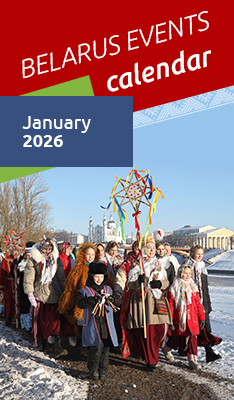




 print version
print version make home page
make home page add to bookmarks
add to bookmarks



